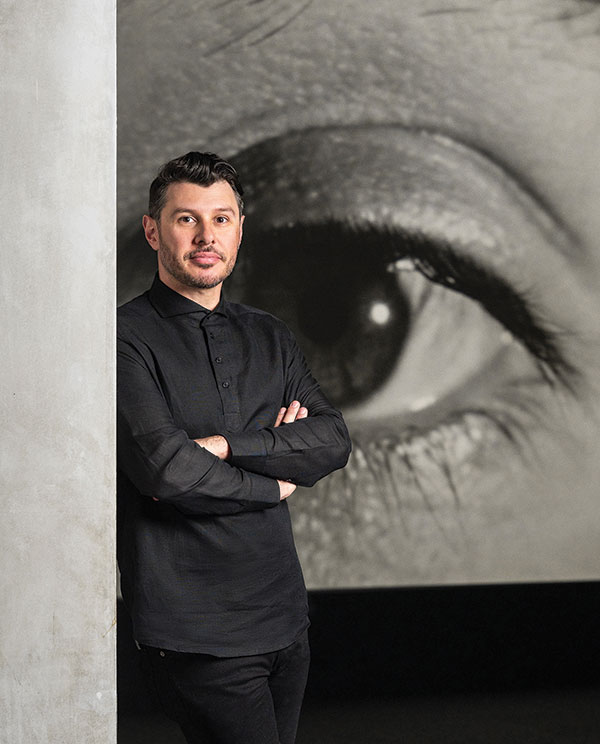 Photo: Abby Warhola
Photo: Abby WarholaContemporary art can be inaccessible to some communities. Aaron Levi Garvey, the new chief curator at The Andy Warhol Museum, wants to change that by bringing art exhibitions into different spaces and supporting emerging talent. Prior to coming to The Warhol, Garvey was the Janet L. Nolan Director of Curatorial Affairs at the Jule Collins Smith Museum of Fine Art at Auburn University, where he helped update policies around diversity, equity, inclusion, and access, and acquired works by leading women, people of color, and LGBTQ+ artists. Before that, he was chief curator at The Hudson Eye/Jonah Bokaer Arts Foundation in Hudson, New York. And with his partner, Stevie Covart Garvey, he spearheaded the Jacksonville, Florida-based Long Road Projects, a publishing house, residency program, and artist support network.
Q: What drew you to curating at The Warhol?
A: Warhol always worked with what was current, new, or experimental. He was most interested in new developments in media and technology, and in my opinion, his practice was the epitome of contemporary. From one of his experiments in early film to the Blondie drawing created on Commodore’s Amiga 1000 and his work with image manipulation in the pre-digital era—these contemporary media explorations were at the forefront of his studio practice. His influence is everywhere, from fashion to the Super Bowl and everything in between.
Q: What does supporting emerging artists look like for you?
A: I often think about what types of support artists need, then I work to make those things possible. Throughout my curatorial work and the co-founding of a residency program, I saw supporting emerging artists as an import-export model of both highlighting regional and international artists simultaneously—bringing outside artists into a community and then exporting relationships and connections. Rather than asking artists to work for exposure, it’s more: “Artists, come here, so that we can get exposure to you.” Often support comes in many different models and forms, from writing letters of recommendation, leveraging relationships and partnerships, and providing material resources.
Q: Who are some of the artists you’ve supported early in their careers, through your curatorial work at museums and the Long Road Projects?
A: Gamaliel Rodríguez, Li Hongbo, Masaomi Yasunaga, Shikeith, Elizabeth Webb, Rachel Libeskind, Rachel Rossin with solo exhibitions; and Paul Weiner, Curtis Talwst Santiago, Dustin Harewood, T.J. Dedeaux-Norris, Tony Rodrigues, and Hiromi Moneyhun through residencies; and some through both. I worked with Rodríguez on his first solo museum exhibition at the SCAD Museum. Fast-forward to now, and he was the signature image at the Whitney for their 2023 exhibition No existe un mundo poshuracán. Shikeith is based in Pittsburgh and has been a longtime collaborator. We mounted a solo project at Atlanta Contemporary together, and during his Long Road Projects residency, he began research and a body of work that eventually became the crux of his first monograph “notes toward becoming a spill.”
Q: You focus a lot on diversity, equity, and inclusion. What does that concept mean to you and how do you implement it in your museum work?
A: I have always felt that, if I have a seat at the table, it is my duty to either bring others to the table with me or give up my seat so that others can be there. I am a facilitator and conduit.
As a third-generation Jewish person in North America, so much of what I focus on in building relationships is an evolution of the values my great-grandmother instilled in me. And much of that means facilitating access. I have focused most of my efforts on creating unique opportunities of support for artists, educational opportunities for communities to more deeply understand the arts and humanities, and creating arts spaces that are comfortable and welcoming for all folks in order to break the stigmas associated within the arts as being elitist.
Q: How do you see yourself implementing that community-building strategy in Pittsburgh?
A: I want there to be a kind of “leveling” or “even-ing” in the community. We are evenly all rowing in the same direction, trying to make this city an arts epicenter. I want people to think of Pittsburgh beyond just the Carnegie International, beyond the Steelers, the Penguins, the Pirates. I’ll be at all of those games—but I want people to think of the city for the arts. This is a place for artists to live, and live well. I’d like to bring people here that have never been to the city, as well as uplift artists within the region with museum support. There’s a lot of growth in Pittsburgh in both the museum and underground scenes. The convergence of the underground and highbrow was Warhol. That’s why I’m so excited about this museum and city!
Receive more stories in your email
Sign up